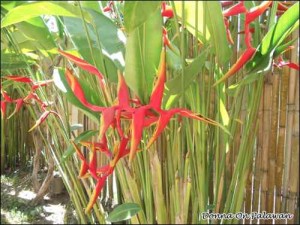Grating Kamoteng Kahoy (Cassava)
by Donna Amis Davis
 (To continue the theme of Food, I am reposting an article I wrote awhile ago about the Palawanos’ staple food – sengley kayo, or kamoteng kahoy in Tagalog. English is cassava, I think.)
(To continue the theme of Food, I am reposting an article I wrote awhile ago about the Palawanos’ staple food – sengley kayo, or kamoteng kahoy in Tagalog. English is cassava, I think.)
The other day I visited Aming’s house, and came across Bibi doing something I hadn’t seen before. She had a big piece of sengley kayo, and was grating it into a plastic dish tub. Sengley kayo is one of the Palawanos’ staple foods. It is the starchy root of a plant. Sengley kayo means “wood sweet potato.” It is the shape of a sweet potato, but much larger, and yes, it is woody. The flesh is white, though, not pink or orange. And it is not sweet. They are easy to plant. Just take the stalks of sengley kayo plants that have been already dug up, chop the stalks into four- or five-inch sections, and thrown them on the rice field where you have just harvested this year’s crop of rice. It grows with no attention. No weeding, feeding or watering are needed. It is a low maintenance food, but also one that seems to me to lack flavor and much nutrition. It fills empty bellies, though, when the rice harvest starts to run out.
Bibi told me all about what she was doing. She had traded for this bunch of sengley kayo from a man named Bilintino for some rock salt. Apparently Bibi and her husband had extra rock salt, and Bilintino had extra sengley kayo, so a deal was struck. She peeled off the rough dark skin, soaked them in water to get any dirt off, and then started grating them. She said they aren’t too hard to grate. I asked her why she grated them. I knew the common way to cook them was to roast them over a fire, or boil them in a pot. She said that when you grate them you can use more of the root, even the tough middle part. So you don’t waste as much food. Boiling or roasting doesn’t allow the tough middle to soften enough to be edible, and then that part is wasted.
After grating them, Bibi will wrap it all up in a rice sack and press it with a board to get the water out. Then when it is drained like that, the sengley kayo is ready to be cooked. Bibi said she cooks it two ways. Either she puts it in a wok with grated coconut and cooks them up together, or she wraps handfuls of grated sengley kayo in squares of banana leaves, and boils them in water, to make little portable snack-size servings.
I have to tell you, I was impressed. Here is a “food” that to my taste buds is virtually inedible. Yet Bibi was working hard to make use of every last bit of it, and not waste any of it. Am I rich and spoiled? Yes, I’m afraid I am.


So, what do you think?